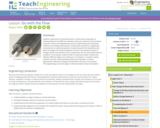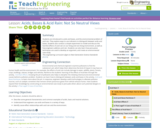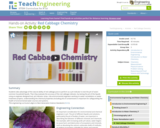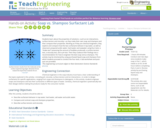
This tutorial presents a review of the definitions for pH and buffer solutions
- Subject:
- Science
- Material Type:
- Lesson
- Provider:
- Chemistry Collective
- Date Added:
- 08/03/2022

This tutorial presents a review of the definitions for pH and buffer solutions

An introduction to pH and the pH scale. See examples of calculating pH of pure water, bleach, and orange juice. [11:38]
Khan Academy learning modules include a Community space where users can ask questions and seek help from community members. Educators should consult with their Technology administrators to determine the use of Khan Academy learning modules in their classroom. Please review materials from external sites before sharing with students.

How can an understanding of pH—a logarithmic scale used to identify the acidity or basicity of a water-based solution—be used to design and create a color-changing paint? This activity provides students the opportunity to extract dyes from natural products and test dyes for acids or bases as teams develop a prototype “paint” that is eventually applied to help with a wall redesign at a local children’s hospital. Students learn about how dyes are extracted from organic material and use the engineering design process to test dyes using a variety of indicators to achieve the right color for their prototype. Students iterate on their dyes and use ratios and proportions to calculate the amount of dye needed to successfully complete their painting project.

To reinforce students' understanding of the human digestion process, the functions of several stomach and small intestine fluids are analyzed, and the concept of simulation is introduced through a short, introductory demonstration of how these fluids work. Students learn what simulation means and how it relates to the engineering process, particularly in biomedical engineering. The teacher demo requires vinegar, baking soda, water and aspirin.

Students gain an understanding of the difference between electrical conductors and insulators, and experience recognizing a conductor by its material properties. In a hands-on activity, students build a conductivity tester to determine whether different objects are conductors or insulators. In another activity, students use their understanding of electrical properties to choose appropriate materials to design and build their own basic circuit switch.

There are many different types of vinegar that you can buy to use around the kitchen for cooking and pickling. The chemical compound that gives vinegar its tart taste and pungent smell is acetic acid. In this experiment you will work to discover if different vinegars have different amounts of acetic acid, and how much variation exists between different types.

Students are introduced to acids and bases, and the environmental problem of acid rain. They explore ways to use indicators to distinguish between acids and bases. Students also conduct a simple experiment to model and discuss the harmful effects of acid rain on our living and non-living environment, as well as how engineers address acid rain. In an associated literacy activity, students learn how persuasive techniques are used to develop an argument, and create an environmental case study.

This PBS series takes a hard look at teenage drug use. Content includes a focus on how and why teens use drugs, the long-term health effects of drug use, and more.

The reaction of acids and bases and what ions are produced and the salts that form.
A free CK-12 account is required to view all materials.

In a class demonstration, the teacher places different pill types ("chalk" pill, gel pill, and gel tablet) into separate glass beakers of vinegar, representing human stomach acid. After 20-30 minutes, the pills dissolve. Students observe which dissolve the fastest, and discuss the remnants of the various pills. What they learn contributes to their ongoing objective to answer the challenge question presented in lesson 1 of this unit.

This pathway explores the properties of water that make it essential for life. Key properties of water discussed in this pathway include water as a solvent, hydrogen bonding, specific heat and cohesion.

In this scrollable interactive, the four levels of protein folding are explored in detail by exploring the structure of hemoglobin.

Students take advantage of the natural ability of red cabbage juice to perform as a pH indicator to test the pH of seven common household liquids. Then they evaluate the accuracy of the red cabbage indicator, by testing the pH of the liquids using an engineer-designed tool, pH indicator strips. Like environmental engineers working on water remediation or water treatment projects, understanding the chemical properties (including pH) of contaminants is important for safeguarding the health of environmental water sources and systems.

Students learn about the properties of solutions—such as ion interactions, surface tension and viscosity—as they make their own soap and shampoo and then compare their properties. Working as if they are chemical engineers, they explore and compare how the two surfactants behave in tap water, as well as classroom-prepared acidic water, hard water and seawater using four tests: a “shake test” (assessing the amount of bubbles produced), a surface tension test, a viscosity test, and a pH test. Then they coalesce their findings into a recommendation for how to engineer the best soap versus shampoo. The activity may be shortened by using purchased liquid soap and shampoo from which students proceed to conduct the four tests. A lab worksheet and post-quiz are provided.

Problem sets, tutorials, and activities related to biochemistry.